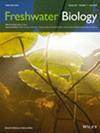High Altitudes as Reservoirs of Unique Genetic Diversity: A Case Study on Aquatic Beetles in Glacial Lakes of Tatra Mountains
IF 2.7
2区 生物学
Q2 ECOLOGY
引用次数: 0
Abstract
- Mountains play a crucial role in global biodiversity, serving as refugia for many endemic and endangered species. This extends to high-altitude freshwater habitats, such as glacial lakes and ponds, which support unique communities of cold-adapted invertebrates. However, their remoteness, short ice-free periods and difficult accessibility pose challenges for research, leaving key ecosystem aspects poorly understood. This is particularly true for population genetic diversity and structure, which are essential for developing effective conservation strategies, especially in the context of climate change adaptation and biodiversity preservation. This study aims to (i) assess the community composition and genetic diversity and structure of aquatic beetles in the (sub)alpine lakes and ponds of the Tatra Mountains, (ii) compare these populations with conspecifics from lower elevations and (iii) evaluate the role of this mountain system in maintaining unique genetic diversity.
- Macroinvertebrate samples were collected from 215 sites, and a target barcoding fragment was amplified from ~500 aquatic beetles. Furthermore, our dataset was expanded with > 1700 sequences from the BOLD database (Barcode of Life Data Systems) and used for species delimitation with RESL, ASAP and mPTP, as well as for assessing key genetic parameters, including haplotype and nucleotide diversity, intraspecific variation and genetic differentiation. Phylogenetic relationships among haplotypes recorded within the study area were inferred using maximum likelihood analyses, and time-calibrated Bayesian phylogenies were conducted to assess cryptic taxa.
- Aquatic beetles were recorded at 106 sites, yielding 387 DNA barcodes and identifying 68 species from 27 genera and eight families. Of these, 29 species were newly recorded in the region. The expanded dataset comprised 657 haplotypes representing 106 BINs (barcode index numbers), with species delimitation yielding 81 (ASAP) and 92 (mPTP) MOTUs (molecular operational taxonomic units). For species recorded in the Tatra Mountains, approximately 75% of their globally recognised BINs/MOTUs were also present within the region, and three Linnean species were confirmed to include cryptic complexes likely originating in the Pleistocene. Notably, 68% of the 179 haplotypes found in the studied area were unique to this region, with significant genetic differentiation from non-Tatra populations, as shown by AMOVA analyses.
- The study demonstrates that highly diverse (sub)alpine lakes distributed in a geographically small area can harbour substantial species and genetic diversity and serve as important reservoirs of unique genetic diversity. These lakes likely also act as secondary contact sites for the cryptic complexes identified in this study. In contrast, the first recorded findings of some thermophilic and eurytopic species, along with the absence of several previously reported cold-adapted taxa, suggest a potential shift in species composition, likely driven by climate change.
- This research significantly contributes to expanding the regional DNA barcode library and enhancing general understanding of genetic diversity in mountain freshwater ecosystems. The findings are also relevant for biodiversity monitoring efforts and conservation strategies, especially in the context of climate change-driven shifts in community composition, as evidenced by some of the newly recorded species in the Tatra Mts.
高海拔地区是独特遗传多样性的储存库——以塔特拉山脉冰湖水生甲虫为例
山脉在全球生物多样性中发挥着至关重要的作用,是许多特有和濒危物种的避难所。这延伸到高海拔的淡水栖息地,如冰川湖泊和池塘,它们支持独特的适应寒冷的无脊椎动物群落。然而,它们地处偏远,不结冰期短,难以进入,给研究带来了挑战,使人们对关键的生态系统方面知之甚少。对于种群遗传多样性和遗传结构而言尤其如此,它们对于制定有效的保护战略至关重要,特别是在适应气候变化和保护生物多样性的背景下。本研究旨在(i)评估塔特拉山脉(亚)高山湖泊和池塘水生甲虫的群落组成、遗传多样性和结构,(ii)将这些种群与低海拔的同种物种进行比较,(iii)评估该山地系统在保持独特遗传多样性方面的作用。从215个地点收集了大型无脊椎动物样本,并从约500只水生甲虫中扩增了目标条形码片段。此外,我们的数据集扩展了BOLD数据库(条形码of Life Data Systems)中的>; 1700个序列,并使用RESL, ASAP和mPTP进行物种划分,以及评估关键遗传参数,包括单倍型和核苷酸多样性,种内变异和遗传分化。利用最大似然分析推断研究区域内记录的单倍型之间的系统发育关系,并进行时间校准的贝叶斯系统发育来评估隐蔽分类群。水生甲虫在106个地点被记录下来,得到387个DNA条形码,鉴定出8科27属68种。其中29种为新记录种。扩展后的数据集包括657个单倍型,代表106个bin(条形码索引号),物种划分得到81个(ASAP)和92个(mPTP) motu(分子操作分类单位)。在塔特拉山脉记录的物种中,大约75%的全球公认的bin / motu也存在于该地区,并且确认了三个林奈物种包括可能起源于更新世的隐体复合体。值得注意的是,在研究地区发现的179个单倍型中,68%是该地区独有的,与非塔特拉人群存在显著的遗传分化,如AMOVA分析所示。研究表明,分布在小区域内的高多样性(亚)高寒湖泊具有丰富的物种和遗传多样性,是独特遗传多样性的重要储存库。这些湖泊也可能是本研究中发现的隐性复合物的次要接触点。相比之下,一些嗜热和泛栖物种的首次记录发现,以及一些先前报道的冷适应分类群的缺失,表明物种组成的潜在变化,可能是由气候变化驱动的。该研究对扩大区域DNA条形码文库和提高对山地淡水生态系统遗传多样性的认识具有重要意义。这些发现也与生物多样性监测工作和保护策略相关,特别是在气候变化驱动的群落组成变化的背景下,如在塔特拉山脉的一些新记录物种所证明的那样。
本文章由计算机程序翻译,如有差异,请以英文原文为准。
求助全文
约1分钟内获得全文
求助全文
来源期刊

Freshwater Biology
生物-海洋与淡水生物学
CiteScore
5.90
自引率
3.70%
发文量
162
审稿时长
2 months
期刊介绍:
Freshwater Biology publishes papers on all aspects of the ecology of inland waters, including rivers and lakes, ground waters, flood plains and other freshwater wetlands. We include studies of micro-organisms, algae, macrophytes, invertebrates, fish and other vertebrates, as well as those concerning whole systems and related physical and chemical aspects of the environment, provided that they have clear biological relevance.
Studies may focus at any level in the ecological hierarchy from physiological ecology and animal behaviour, through population dynamics and evolutionary genetics, to community interactions, biogeography and ecosystem functioning. They may also be at any scale: from microhabitat to landscape, and continental to global. Preference is given to research, whether meta-analytical, experimental, theoretical or descriptive, highlighting causal (ecological) mechanisms from which clearly stated hypotheses are derived. Manuscripts with an experimental or conceptual flavour are particularly welcome, as are those or which integrate laboratory and field work, and studies from less well researched areas of the world. Priority is given to submissions that are likely to interest a wide range of readers.
We encourage submission of papers well grounded in ecological theory that deal with issues related to the conservation and management of inland waters. Papers interpreting fundamental research in a way that makes clear its applied, strategic or socio-economic relevance are also welcome.
Review articles (FRESHWATER BIOLOGY REVIEWS) and discussion papers (OPINION) are also invited: these enable authors to publish high-quality material outside the constraints of standard research papers.
 求助内容:
求助内容: 应助结果提醒方式:
应助结果提醒方式:


